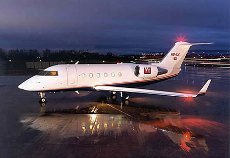
To an outsider, investing in a private jet may seem like an exorbitant and unnecessary charge. If one flight can get hundreds of people to a destination, why does another person need to ride with a small group? Strict accountants may also have the same attitude.
But for the high-flying corporate executive on serious time constraints, waiting for everyone to board and get off of an airplane — even if it’s just those in first class — can not only make them late for important appointments or live events (ex. speaking engagements) but also risk losing money.
According to DesertJet, the hourly cost to charter the aircraft charter through someone like Adagold Aviation includes the following expenses: fuel surcharge; daily minimums (each day the flight is away from its starting destination); repositioning costs (moving from one destination to the next); ramp and landing fees; overnight fees; federal excise tax (FET); segment fees (per person, per leg basis); international segment fees (if crossing the U.S. border); and handler fees.
Forbes estimates the rate of an aircraft charter to be between $1,674 per hour (Citation Mustang) and $8,640 per hour (Gulfstream 550).
Depending on a person’s salary, this may be worth its while or equal to burning money in a campfire.
Weigh the profit cost to get to events on short notice. For executives who need to go on international (or even national) flights that aren’t readily available on short notice, a private jet may be the most obvious resource for traveling back and forth. The accountant will argue that rescheduling the event would get the person wherever they need to go, but the executive’s clients may not be this flexible. If the client is stuck in between the two and the client will lose money because of missing this event, the accountant should be more concerned with profit versus loss.
Calculate how much profit will be made after travel expenses. If a new account leads to $10,000 deal, but the rate to get there (even on the least expensive private jet —Citation) is 10 hours round trip at $16,740, the executive ends up owing. Even $20,000 only leads to approximately $4,000. But make that same account $100,000 on even the most expensive flight (Gulfstream) at a rate of $86,400. That’s $13,600. For the busy executive, this is still small cash. In this case, the trip on an aircraft charter still isn’t worth it.
Find ways to make the trip worth the travel time. However, using that same example above, let’s just say that that same executive has two deals going on in the same country. While he may gain only $13,600 from one account, if there’s a second account for a large amount, the trip could be worth it. However, the daily minimum charges should be calculated between these two meetings. If they’re spaced too far apart, the fees for the jet will eat into the second set of profits.
Monitor what the expenses will be if the event is canceled. Wedding venues aren’t the only company that charge cancellation fees and late fees. These fees are especially popular for live events where others have paid to see another person, such as the executive, in live quarters. Instead of having to appease a couple of other business executives, a group of people’s time and money are on the line. Calculate how much the tickets are for a speaking event, who would be in the crowd that is worth networking with later and publicity perks.
There is no right or wrong answer on whether a private plane is worth the money. It all depends on a combination of how much the event costs, what the executive stands to gain, the time constraints he’s on and how flexible other work options are. While leisurely flights and convenience won’t impress a responsible accountant, profit will more than likely make her see the other side of the coin.
Related posts:






